Considering the applications of look-aheads and optimizers
Although pipelines remain the safest method of transporting any fuel, they are not without their risks. Look-aheads and optimizers work together to play a crucial role in effectively anticipating risks and violations on a pipeline and prompting actions so appropriate measures can be taken to mitigate future issues.1
Seeing the future with look-aheads
Current states in a pipeline network are saved regularly on site by the system and each state offers insight into the pipeline’s conditions and learnt parameters throughout the pipeline network.
When paired with a live system, look-aheads are able to predict the future of a pipeline system by simulating a variety of potential scenarios. It achieves this by finding the latest online saved state and using it to simulate an “offline” scenario, ramping up from the latest online saved state to the start point of the requested scenario. This process of connecting a live production system with offline studies enables look-aheads to predict a future where a gas pipeline might have inventory violations, delivery shortfalls or unexpected shut-downs (see Figure 1).
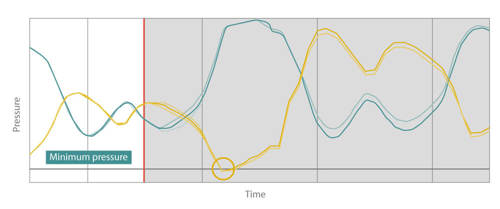
Figure 1: Trending data from a live pipeline’s recent activity (light background), along with the look-ahead’s prediction of a future scenario. The circled area signposts a potential minimum pressure violation that can be prevented by taking actions early.
The three types of look-ahead
Pipeline companies sometimes use a range of jargons to describe the different types of look-ahead, but the three main examples can be best understood as frozen-look-aheads, what-if look-aheads and nominations look-aheads.
Frozen look-ahead scenarios
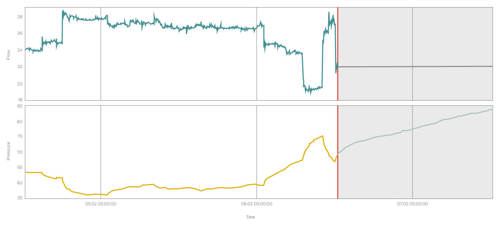
Figure 2: Visual representation of a frozen look‑ahead maintaining flow rates from the initial state to predict how pressure, inventory and other parameters would vary if all flow rates continued as normal.
Unlike an offline scenario, an online scenario doesn’t have the facility for control modes, meaning it is assigned modes based on user input. Simulation software like Atmos SIM overcomes this challenge with advanced look-ahead functionality that requires no user overrides. A frozen-lookahead can run in the background of pipeline operations, predicting survivability in the event that everything in the scenario stays the same as it did in the initial state. To keep control of flow, frozen look-aheads sometimes allow pressures and inventory to vary.
What-if look-ahead scenarios
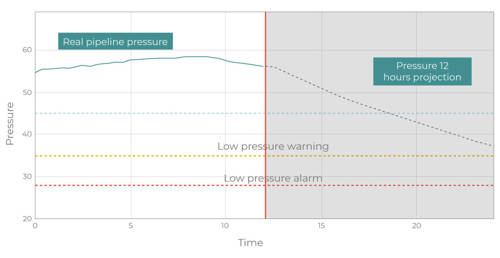
Figure 3: A what-if look-ahead charting pressure decreases in the event of a compressor station tripping
In comparison to a frozen look-ahead, a what if-look-ahead considers what would happen in the transition from current pipeline conditions to a new situation, asking questions around what the impact would be on a pipeline if an event took place, like a compressor tripping or an emergency shut-down.
Atmos SIM devotes a significant amount of time and code to this look-ahead scenario, because it requires data communication between the solution of an online scenario and the solution of an offline scenario.
Insights from a what-if scenario can contribute towards the overall safety of pipeline operations and security of supply, leading to recommendations from pipeline operators that shut-downs be performed more cautiously or avoided completely, for example. Many different what-if scenarios can be simulated to look into the future so that the best plan can be put forward to the pipeline operators. Figure 3 shows what could happen to the delivery pressure if one of the compressor stations trips: the pressure continues to fall but it is still above the low pressure warning level after 12 hours. If actions are taken before the alarm level is reached the pipeline can continue to deliver gas to the customer.
Nominations look-ahead scenarios
To ensure supply and demand requirements are met, a nominations look-ahead scenario provides forecasting of pipeline conditions on a routine level in response to shippers’ nominations. It’s an exact method, often varying upcoming flow rates over time. The constraints can be overridden if a time-sensitive order comes in.
In terms of ensuring results are delivered long into the future, a nominations look-ahead scenario helps to avoid overruns by improving production planning.
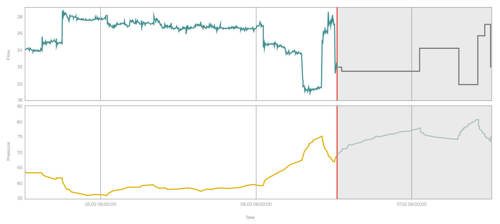
Figure 4: Compared to a frozen-look-ahead scenario (Figure 2), a nominations look-ahead provides more visibility into future operations and has a higher certainty (The top trend in the grey background is the nomination and the bottom trend the corresponding pressure)
Ad-hoc look-ahead scenarios
While the three main types of look-ahead are used often, it’s worth noting that the user has the ability to build any look-ahead scenario to suit the requirements of their pipeline operations plan. Simulation software like Atmos SIM can be leveraged to predict the future of a pipeline.
While a look-ahead simulation looks at a variety of possible scenarios, an optimizer’s purpose is to identify the best option out of a range of possible alternatives.
Goal-seeking with optimization
Optimizers work most effectively when they are tailored for each requirement on the pipeline. For example, a pipeline designer may want to see the operational costs of a pipeline in typical conditions and the capacity limits, whereas a pipeline operator might use an optimizer to plan their future operations. Accuracy is vital for an optimizer to work effectively in everyday pipeline operations, which our blog on chapter three of “The Atmos book of pipeline simulation” discusses in greater detail.
When an optimizer is based on an accurate pipeline model, it can achieve goals in the most efficient way possible. It can benefit the operations of an entire pipeline network by recommending parameters such as which compressors to run or the settings on a control valve pressure setpoint.
The techniques of an optimizer
When it comes to the options available in optimization, an “optimizer” can range from the simpler scenario-launcher to a general solver that can minimize operational costs while considering other dependencies.
One application for an optimizer is in a scenario which could have multiple outcomes. In this context an optimizer can launch a multitude of scenarios and reach the best solution by trial and error, automating a rinse and repeat procedure that pipeline operators would have ordinarily performed manually.
In the case of a liquid pipeline, capacity can be optimized through a basic procedure like the Newton-Raphson iteration, which calculates a pipeline’s closest approaches to the lowest allowable operating pressure (LAOP) and maximum allowable operating pressure (MAOP).
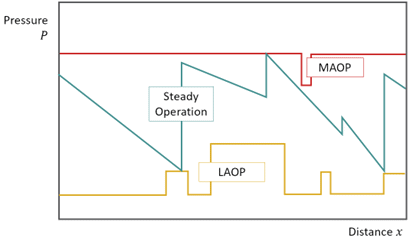
Figure 5: The pressure change (teal) in a liquid pipeline encountering the lowest allowable operating pressure (LAOP, yellow) and maximum allowable operating pressure (MAOP, red). It’s worth noting a bottleneck occurs where pressure touches MAOP to the downstream point it touches LAOP
This optimization technique enables pipeline operators to identify opportunities when flow rate can be increased or decreased.
The problem with optimization in a simple scenario is that it’s limited by its inability to answer more complex questions relating to pipelines, but the use of artificial intelligence shows promise in overcoming this.
Through its ability to handle large amount of site data and simulation results, its capacity for continuous improvement and its ability to make predictions agnostic of any human involvement, artificial intelligence has potential in the future to use large scale pipeline data sets.
Predicting and preparing for the future with look-aheads and optimizers
Pipeline simulation software like Atmos SIM can facilitate the use of look-aheads to predict future operational conditions, while optimizers are being increasingly used to identify areas for improvement, automate tasks and free up pipeline operators’ time to focus on other priorities.
References
1 “The Atmos Book of Pipeline Simulation”
Download chapter 12 Order the book
Ready for chapter 13?
Chapter 13 covers how multi-phase flow regimes can be modeled by a pipeline simulator as long as accuracy is a priority.
